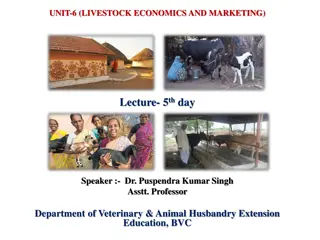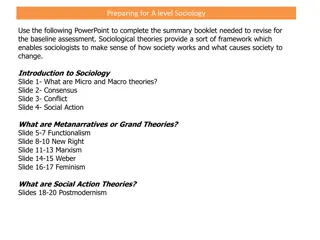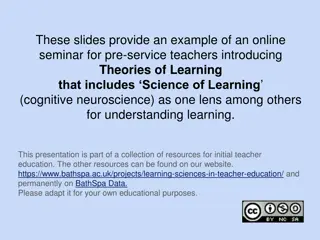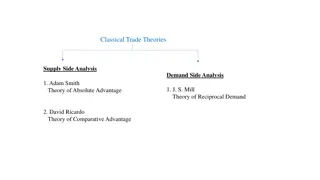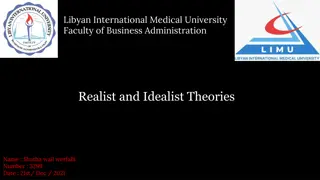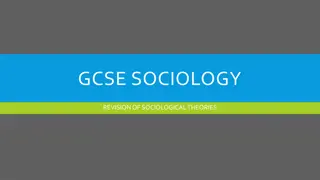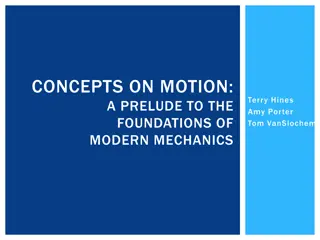Understanding Theories and Concepts in Research
The content delves into the fundamental concepts of theories and variables in research. It discusses the nature of theories, including descriptive, explanatory, and predictive theories. Additionally, it examines the role of concepts in providing identity and meaning to objects and phenomena. Through explanations and visual aids, the content aims to enhance comprehension of theoretical frameworks and hypothesis development in research.
Download Presentation

Please find below an Image/Link to download the presentation.
The content on the website is provided AS IS for your information and personal use only. It may not be sold, licensed, or shared on other websites without obtaining consent from the author. Download presentation by click this link. If you encounter any issues during the download, it is possible that the publisher has removed the file from their server.
E N D
Presentation Transcript
Theories, Theories, T Theoretical Framework, heoretical Framework, Variables, Variables, Hypothesis Development Hypothesis Development Zulkarnain Lubis
Theory Theory A broad abstract characterization of phenomena, a generalization that presents a systematic explanation about the relationships among phenomena. Its writings include terms such as propositions, premise, law and principles An explanation establishes the substantive meaning of constructs, variables, and their linkages, while a prediction tests that substantive meaning by comparing it to empirical evidence A theory is a system of constructs and variables in which the constructs or variables are related to each other by propositions or hypotheses, within the boundary that sets the limitations and assumptions in applying it (e.g., values, context, space, time)
THEORY A set of interrelated constructs (concepts), definitions, and propositions that presents a systematic view of phenomena by specifying relations among variables, with the purpose of explaining and predicting the phenomena It is a statement of relationship between two variables, one acting as the independent variable, another as the dependent variable Theory is developed by which to explain and predict complex events, objects or phenomena. An explanation establishes the substantive meaning of constructs, variables, and their linkages, while a prediction tests that substantive meaning by comparing it to empirical evidence
Theories Descriptive theories describe or classify specific dimensions or characteristics of individuals, groups, situations, or events by summarizing the commonalities found in discrete observations Explanatory theories specify relations among the dimensions or characteristics of individuals, groups, situations, or events Explanatory theories are tested by using correlational research Predictive theories are intended to predict precise relationships between the dimensions or characteristics of a phenomenon or differences between groups
Concept Concept Abstractly describes and names an object and Abstractly describes and names an object and phenomenon, thus providing it with a separate phenomenon, thus providing it with a separate identity and meaning identity and meaning An intellectual representation of some aspect An intellectual representation of some aspect of reality that is derived from observations of reality that is derived from observations made from phenomenon made from phenomenon The building block of theory; a word picture or The building block of theory; a word picture or mental idea of a phenomenon, and a word or mental idea of a phenomenon, and a word or term that symbolizes certain aspect of reality. term that symbolizes certain aspect of reality. Concentrate on the human brain, abstract, Concentrate on the human brain, abstract, intelligence intelligence
Concept Concept The building block of theory; a word picture or mental idea of a The building block of theory; a word picture or mental idea of a phenomenon, and a word or term that symbolizes certain aspect of phenomenon, and a word or term that symbolizes certain aspect of reality. Concentrate on the human brain, abstract, intelligence reality. Concentrate on the human brain, abstract, intelligence Expresses an abstraction formed by generalization from particulars. Expresses an abstraction formed by generalization from particulars. E.g. "weight expresses numerous observations of things that are more E.g. "weight expresses numerous observations of things that are more or less "heavy or "light." Others: Mass, energy, force, achievement, or less "heavy or "light." Others: Mass, energy, force, achievement, intelligence, motivation, extraversion., aggressiveness, conformity. intelligence, motivation, extraversion., aggressiveness, conformity.
Constructs Constructs Concepts adapted for a scientific purpose Concepts adapted for a scientific purpose Concepts at a very high levels of abstraction Concepts at a very high levels of abstraction that have general meaning that have general meaning Used to identify a phenomenon or a situation Used to identify a phenomenon or a situation that can not be directly observed but needs that can not be directly observed but needs to be inferred by certain concentrate or to be inferred by certain concentrate or abstract indicators of phenomenon. It can be abstract indicators of phenomenon. It can be ascertained only by using certain observable ascertained only by using certain observable and measurable procedures. Example of and measurable procedures. Example of Construct: physical health, inferred, Construct: physical health, inferred, assessment. assessment.
Construct Construct Used to identify a phenomenon or a situation that can not be directly Used to identify a phenomenon or a situation that can not be directly observed but needs to be inferred by certain concentrate or abstract observed but needs to be inferred by certain concentrate or abstract indicators of phenomenon. It can be ascertained only by using certain indicators of phenomenon. It can be ascertained only by using certain observable and measurable procedures. Example of Construct: observable and measurable procedures. Example of Construct: physical health, inferred, assessment. physical health, inferred, assessment. is a concept with added meaning, deliberately and consciously is a concept with added meaning, deliberately and consciously invented or adopted for a invented or adopted for a special scientific special scientific purpose." (p.29) E.g. intelligence intelligence used for a special purpose to relate to school used for a special purpose to relate to school achievement and to other variables of interest. achievement and to other variables of interest. purpose." (p.29) E.g.
Proposition Proposition A statement or assertion of the relationship between concept derived from theories or generalizations based on empirical data A statement or assertion of a relationship between concepts theories or generalizations founded on empirical data are sources of proposition statements. A A statement statement or or assertion theories theories or or generalizations generalizations founded proposition proposition statements statements. . assertion of of a a relationship founded on relationship between on empirical empirical data between concepts data are are sources concepts sources of of
Conceptualization: The process of forming basic idea, designs, plans or strategies based on given facts, situations and examples Operational definition: Assigns a meaning to a construct or a variable by specifying the activities or operations necessary to measure it
Conceptualizing the Research Study Conceptualizing the Research Study The The title Purpose Purpose statement overall direction or focus for the study Research Research questions questions: : interrogative statements that narrow the purpose statement to specific questions that researchers seek to answer in their study Research Research hypotheses hypotheses: : declarative statements in quantitative research in which the investigator makes a prediction or conjecture about the outcomes relationship Research Research objectives objectives: statements of intent for the study that specifies specific goals that the investigator plans to achieve in a study title itself itself is is the statement: : a declarative statement that advances the the objective/purpose objective/purpose
Theoretical Framework Theoretical Framework A theoretical framework is a conceptual model of how one theorizes or makes logical sense of the relationships among the several factors that have been identified as important to the problem Theoretical / conceptual framework using material from the Literature Review, produce the working definition of the main concepts you will use in your study. Integrating your logical beliefs with published research, taking into consideration the boundaries and constrains governing the situation The theoretical framework discusses the interrelationships among the variables that are deemed to be integral to the dynamics of the situation being investigated
A theoretical framework is a schematic diagram which able to help in deciding and explaining the route that we are interested to take. From the theoretical framework, a conceptual framework can be developed, variables can be identified, and hypotheses to be tested can be constructed The theoretical framework provides a general representation of relationships between things in a given phenomenon, on the other hand, the conceptual framework, embodies the specific direction by which the research will have to be undertaken
Statistically speaking, the conceptual framework describes the relationship between specific variables identified in the study. It also outlines the input, process and output of the whole investigation. The conceptual framework is used in research to outline possible courses of action or to present a preferred approach to an idea or thought. The conceptual framework is also called the research paradigm.
Functions of theoretical framework It It provides provides the the the data data analysis It It identifies identifies the It It explains explains why another another or or why possibly possibly influence It It limits limits the by by focusing focusing on It It stipulates stipulates .. ..in in analyzing the general general framework analysis the variables variables to to be why one one variable why the the independent influence the the dependent dependent variable the scope scope of of data data relevant on specific specific variables variables analyzing and framework which which can can guide guide be measured measured variable can independent variable variable relevant to to the can possibly possibly affect variable can affect can the framework framework and interpreting interpreting data data
Developing Theoretical Framework Most studies do not generate new, novel theories from scratch. Instead, they generally work on improving what already exists The additions or deletions of factors are not of sufficient magnitude to substantially alter the core logic of the existing theory. Relationships, not lists, are the domain of theory Authors must be able to identify and delineate how proposed changes affect the accepted relationships between the factors and what contributions you will make It is a common approach to explain why and strengthen logic by borrowing a perspective from other fields, which encourages an alternative explanation or challenge the underlying rationales of accepted theories. Theories are often challenged because their assumptions have been proven unrealistic (e.g., structuration theory and social exchange theory)
Is the TF applicable to all Is the TF applicable to all research? research? Not all research need a Not all research need a theoretical framework, theoretical framework, but correlational and but correlational and causal studies do causal studies do
Theoretical Framework Theoretical Framework Moderating Variables Demographics Age Gender Internet Experience Usefulness Ease of use Playfulness Compatibility Organizational Outcomes Work Inefficiency Security Threats Attitude Towards Internet Abuse Internet Internet Abuse Abuse Peer culture Supervisor culture Family culture Mass media Subjective Norm Psychological Outcomes Depression Loneliness Dependent Dependent Variable Variable Self efficacy Facilitating conditions Workplace privacy Electronic monitoring Internet policy Perceived Behavior Control Outcome Outcome Variables Variables Independent Independent Variables Variables Antecedents Antecedents
Variables a measurable characteristic that varies. It may change from group to group, person to person, or even within one person over time. a characteristic, number, or quantity that increases or decreases over time, or takes different values in different situations.
Dependent Variables: . . . show the effect of manipulating or introducing . . . show the effect of manipulating or introducing the independent variables. For example, if the the independent variables. For example, if the independent variable is the use or non independent variable is the use or non- -use of a new language teaching procedure, then the dependent language teaching procedure, then the dependent variable might be students' scores on a test of the variable might be students' scores on a test of the content taught using that procedure. In other words, content taught using that procedure. In other words, the variation in the dependent variable depends on the variation in the dependent variable depends on the variation in the independent variable. the variation in the independent variable. It can also said as It can also said as presumed effect, response, presumed effect, response, predicted to, consequence, measured outcome predicted to, consequence, measured outcome use of a new
Independent Variables: . . . are those that the researcher has control . . . are those that the researcher has control over. This "control" may involve manipulating over. This "control" may involve manipulating existing variables (e.g., modifying existing existing variables (e.g., modifying existing methods of instruction) or introducing new methods of instruction) or introducing new variables (e.g., adopting a totally new method variables (e.g., adopting a totally new method for some sections of a class) in the research for some sections of a class) in the research setting. Whatever the case may be, the setting. Whatever the case may be, the researcher expects that the independent researcher expects that the independent variable(s) will have some effect on (or variable(s) will have some effect on (or relationship with) the dependent variables. relationship with) the dependent variables. It can be said also as It can be said also as predictor, presumed cause, stimulus, predicted from, antecedent, cause, stimulus, predicted from, antecedent, manipulated manipulated predictor, presumed
Intervening Variables: . . . refer to abstract processes that are not directly . . . refer to abstract processes that are not directly observable but that link the independent and dependent observable but that link the independent and dependent variables. In language learning and teaching, they are variables. In language learning and teaching, they are usually inside the subjects' heads, including various usually inside the subjects' heads, including various language learning processes which the researcher cannot language learning processes which the researcher cannot observe. For example, if the use of a particular teaching observe. For example, if the use of a particular teaching technique is the independent variable and mastery of the technique is the independent variable and mastery of the objectives is the dependent variable, then the language objectives is the dependent variable, then the language learning processes used by the subjects are the intervening learning processes used by the subjects are the intervening variables. variables.
Moderator Variables . . . affect the relationship between the . . . affect the relationship between the independent and dependent variables by independent and dependent variables by modifying the effect of the intervening modifying the effect of the intervening variable(s). Unlike extraneous variables, variable(s). Unlike extraneous variables, moderator variables are measured and moderator variables are measured and taken into consideration. Typical moderator taken into consideration. Typical moderator variables in TESL and language acquisition variables in TESL and language acquisition research (when they are not the major research (when they are not the major focus of the study) include the sex, age, focus of the study) include the sex, age, culture, or language proficiency of the culture, or language proficiency of the subjects. subjects.
Control Variables Language learning and teaching are very complex Language learning and teaching are very complex processes. It is not possible to consider every variable in a processes. It is not possible to consider every variable in a single study. Therefore, the variables that are not single study. Therefore, the variables that are not measured in a particular study must be held constant, measured in a particular study must be held constant, neutralized/balanced, or eliminated, so they will not have neutralized/balanced, or eliminated, so they will not have a biasing effect on the other variables. Variables that have a biasing effect on the other variables. Variables that have been controlled in this way are called control variables. been controlled in this way are called control variables.
Extraneous Variables: . . . are those factors in the . . . are those factors in the research environment which may have an effect on the research environment which may have an effect on the dependent variable(s) but which are not controlled. dependent variable(s) but which are not controlled. Extraneous variables are dangerous. They may damage a Extraneous variables are dangerous. They may damage a study's validity, making it impossible to know whether the study's validity, making it impossible to know whether the effects were caused by the independent and moderator effects were caused by the independent and moderator variables or some extraneous factor. If they cannot be variables or some extraneous factor. If they cannot be controlled, extraneous variables must at least be taken controlled, extraneous variables must at least be taken into consideration when interpreting results. into consideration when interpreting results.
Binary variable: Binary variable: Observations (i.e., dependent variables) Observations (i.e., dependent variables) that occur in one of two possible states, often labelled zero that occur in one of two possible states, often labelled zero and one. E.g., improved/not improved and completed and one. E.g., improved/not improved and completed task/failed to complete task. task/failed to complete task. Categorical Variable: Categorical Variable: Usually an independent or predictor Usually an independent or predictor variable that contains values indicating membership in one variable that contains values indicating membership in one of several possible categories. E.g., gender (male or of several possible categories. E.g., gender (male or female), marital status (married, single, divorced, female), marital status (married, single, divorced, widowed). The categories are often assigned numerical widowed). The categories are often assigned numerical values used as values used as lable lable, e.g., 0 = male; 1 = female. Synonym , e.g., 0 = male; 1 = female. Synonym for nominal variable. for nominal variable.
Confounding variable: Confounding variable: A variable that obscures the effects of A variable that obscures the effects of another variable. If one elementary read another variable. If one elementary read- - ing phonics textbook in her class and another instructor used a whole phonics textbook in her class and another instructor used a whole language textbook in his class, and students in the two classes language textbook in his class, and students in the two classes were given achievement tests to see how well they read, the were given achievement tests to see how well they read, the independent variables (teacher effectiveness and textbooks) independent variables (teacher effectiveness and textbooks) would be confounded. There is no way to determine if differences would be confounded. There is no way to determine if differences in reading between the two classes were caused by either or both in reading between the two classes were caused by either or both of the independent variables. of the independent variables. Continuous variable: Continuous variable: A variable that is not restricted to particular A variable that is not restricted to particular values (other than limited by the accuracy of the measuring values (other than limited by the accuracy of the measuring instrument). E.g., reaction time, neuroticism, IQ. Equal size instrument). E.g., reaction time, neuroticism, IQ. Equal size intervals on different parts of the scale are assumed, if not intervals on different parts of the scale are assumed, if not demonstrated. Synonym for interval variable. demonstrated. Synonym for interval variable. ing teacher used a teacher used a
Control variable: Control variable: An extraneous variable that an An extraneous variable that an investigator does not wish to examine in a study. investigator does not wish to examine in a study. Thus the investigator controls this variable. Also Thus the investigator controls this variable. Also called a covariate. called a covariate. Criterion variable: Criterion variable: The presumed effect in a non The presumed effect in a non experimental study. experimental study. Dichotomous variable: Dichotomous variable: Synonym for binary Synonym for binary variable variable Discrete variable : Discrete variable : Variable having only integer Variable having only integer values. For example, number of trials need by a values. For example, number of trials need by a student to learn a memorization task. student to learn a memorization task.
Dummy Variables: Dummy Variables: Created by recoding categorical variables that Created by recoding categorical variables that have more than two categories into a series of binary variables. have more than two categories into a series of binary variables. E.g., Marital status, if originally labelled 1=married, 2=single, E.g., Marital status, if originally labelled 1=married, 2=single, and 3=divorced, widowed, or separated, could be redefined in and 3=divorced, widowed, or separated, could be redefined in terms of two variables as follows: var_1: 1=single, 0=otherwise. terms of two variables as follows: var_1: 1=single, 0=otherwise. Var_2: 1=divorced, widowed, or separated, 0=otherwise. Var_2: 1=divorced, widowed, or separated, 0=otherwise. For a married person, both var_1 and var_2 would be zero. In For a married person, both var_1 and var_2 would be zero. In general, a categorical variable with k categories would be general, a categorical variable with k categories would be recoded in terms of k recoded in terms of k - - 1 dummy variables. Dummy variables are 1 dummy variables. Dummy variables are used in regression analysis to avoid the unreasonable used in regression analysis to avoid the unreasonable assumption that the original numerical codes for the categories, assumption that the original numerical codes for the categories, i.e., the values 1, 2, ..., k, correspond to an interval scale. Use: to i.e., the values 1, 2, ..., k, correspond to an interval scale. Use: to place cases in specific groups. place cases in specific groups.
Endogenous variable : Endogenous variable : A variable that is an inherent A variable that is an inherent part of the system being studied and that is deter part of the system being studied and that is deter- - mined from within the system. A variable that is mined from within the system. A variable that is caused by other variables in a causal system. caused by other variables in a causal system. Exogenous variable: Exogenous variable: A variable entering from and A variable entering from and determined from outside of the system being studied. determined from outside of the system being studied. A causal system says nothing about its exogenous A causal system says nothing about its exogenous variables. variables. Interval variable: Interval variable: Synonym for continuous variable Synonym for continuous variable
Latent variable: Latent variable: An underlying variable that cannot be An underlying variable that cannot be observed. It is hypothesized to exist in order to explain observed. It is hypothesized to exist in order to explain other variables, such as specific behaviors, that can other variables, such as specific behaviors, that can be observed. be observed. Example: if we observe the voting records of members Example: if we observe the voting records of members of the House of Representatives on spending bills for of the House of Representatives on spending bills for the military, food stamps, law enforcement, and the military, food stamps, law enforcement, and promoting business investment, we might find promoting business investment, we might find underlying patterns that could be explained by underlying patterns that could be explained by postulating latent variables such as conservatism and postulating latent variables such as conservatism and liberalism. liberalism.
Manifest variable: Manifest variable: An observed variable assumed to indicate An observed variable assumed to indicate the presence of a latent variable. Also known as an indicator the presence of a latent variable. Also known as an indicator variable. We cannot observe intelligence directly, for it is a variable. We cannot observe intelligence directly, for it is a latent variable. We can look at indicators such as vocabulary latent variable. We can look at indicators such as vocabulary size, success in one s occupation, IQ test score, ability to play size, success in one s occupation, IQ test score, ability to play complicated games (e.g., bridge) well, writing ability, and so complicated games (e.g., bridge) well, writing ability, and so on. on. Manipulated variable: Manipulated variable: Synonym for independent Synonym for independent variable. Mediating variable: Mediating variable: Synonym for intervening variable. Synonym for intervening variable. Example: Parents transmit their social status to their children Example: Parents transmit their social status to their children directly, but they also do so indirectly, through education: viz. directly, but they also do so indirectly, through education: viz. Parent s status Parent s status child s education child s education child s status variable. child s status
Nominal variable: Nominal variable: Synonym for categorical variable. Synonym for categorical variable. Ordinal variable: Ordinal variable: A variable used to rank a sample of individuals A variable used to rank a sample of individuals with respect to some characteristics, but differences (i.e., with respect to some characteristics, but differences (i.e., intervals) and different points of the scale are not necessarily intervals) and different points of the scale are not necessarily equivalent. Examples: anxiety might be rated on a scale none, equivalent. Examples: anxiety might be rated on a scale none, mild, moderate, and severe, with numerical values of 0, 1, mild, moderate, and severe, with numerical values of 0, 1, 2, 3. A patient with an anxiety score of 1 is ranked as less 2, 3. A patient with an anxiety score of 1 is ranked as less anxious than a patient with a score of 3, but patients with anxious than a patient with a score of 3, but patients with scores 0 and 2 do not necessarily have the same differences in scores 0 and 2 do not necessarily have the same differences in anxiety as patients with scores of 1 and 3. anxiety as patients with scores of 1 and 3. Outcome variable: Outcome variable: The presumed effect in a non experimental The presumed effect in a non experimental study. Synonym for criterion variable. study. Synonym for criterion variable.
Polychotomous Polychotomous variables: than two possible values. Strictly speaking, this includes than two possible values. Strictly speaking, this includes all but binary variables. The usual reference is to all but binary variables. The usual reference is to categorical variables with more than two categories. categorical variables with more than two categories. Predictor variable: Predictor variable: The presumed cause on a non The presumed cause on a non experimental study. Often used in correlational studies. experimental study. Often used in correlational studies. For example, SAT scores predict first semester GPA. The For example, SAT scores predict first semester GPA. The SAT score is the predictor variable. SAT score is the predictor variable. Treatment variable: Treatment variable: Synonym for independent variable Synonym for independent variable variables: Variables that can have more Variables that can have more
Process of Hypothesis Generation Process of Hypothesis Generation Theory Concept Concept Concept Proposition Proposition Hypothesis Hypotheses should express relationships between variables in an Hypotheses should express relationships between variables in an unambiguous, precise manner, and they should be based on the unambiguous, precise manner, and they should be based on the propositions that evolved from the theoretical framework propositions that evolved from the theoretical framework
Definition Definition A statement logically formed an opinion on the basis of relationships between two or more variables. An opinion is made on the basis of theoretical network. A statement that shows a relationship between two or more variables in testable form. A proposition formulated for empirical testing a prediction for the outcome of an experiment Explains facts and guides the research to possible outcomes
The Roles of Hypotheses The Roles of Hypotheses 1. It guides the direction of the study. 2. It identifies facts are relevant and those that are not. 3. It suggests which form of research design is likely to be most appropriate. 4. It provides a framework.
Types Of Hypotheses Types Of Hypotheses Descriptive hypotheses 1. Null hypothesis proposition, no relationship 2. Alternate hypothesis expressing a relationship Relational hypotheses 1. Correlational hypotheses 2. Explanatory (causal) hypotheses Correlational Hypothesis Correlational Hypothesis A statement indicating that variables occur together in a some specified manner WITHOUT that one causes the other Eg: Students in urban areas obtain more favorable grades in Mathematics than do students in rural areas.
Types Of Hypotheses Types Of Hypotheses Exploratory (Causal) Hypothesis Exploratory (Causal) Hypothesis A statement that describes a relationship between two variables in which one variable leads to a specified effect on the other variable. Eg. An increase in family income leads to an increase in the percentage of income saved.
Hypothesis Format Hypothesis Format If-then statement If the employees are more healthy, then they will take sick leave less frequently. Directional The greater the stress experienced in the job, the lower the job satisfaction. Non directional There is a relationship between age and job satisfaction
Writing A Proper Hypothesis: Writing A Proper Hypothesis: A hypothesis must satisfy the following requirements the following requirements A hypothesis must satisfy Be expressed in a declarative statement Postulate a relationship between variables Reflect a theory which will guide the research Be brief and concise Be testable and/or provable
Writing A Proper Hypothesis: Writing A Proper Hypothesis: Steps to Writing the If section of your Hypothesis the If section of your Hypothesis Steps to Writing 1. Start your sentence with the word If 2. Write down one of the variables 3. Connect statement with one of the following: is related to is affected by causes 4. Write down the other variable
Writing A Proper Hypothesis: Writing A Proper Hypothesis: Writing the Then section of your Hypothesis section of your Hypothesis Writing the Then Write the word then (following the if section) Make a comment on the relationship between those two variables. Ex. If section: If section: If water is related to plant growth, Ex. Then section: Then section: then the more you water plants, the bigger they will grow. If water is related to plant growth, then the more you water plants, the bigger they will grow.
Directional and Non Directional and Non- -directional Hypotheses directional Hypotheses If, in stating the relationship between two variables or comparing two groups, terms such as positive, negative, more than, less than, and the like are used, then these hypotheses are directional directional because the direction of the relationship between the variables is indicated. Example: The greater the stress experienced in the job, the lower the job satisfaction of employee Women are more motivated than men
Directional and Non Directional and Non- -directional Hypotheses directional Hypotheses Non-directional hypotheses are formulated either because the relationships or differences have never been previously explored and hence there is no basis for indicating the direction, or because there have been conflicting findings in previous research studies on the variable. Example: There is a relationship between age and job satisfaction. There is a difference between the work ethic values of American and Asian employees.
Hypothesis Testing Hypothesis Testing The steps to be followed in hypothesis testing are: The steps to be followed in hypothesis testing are: 1. 1. State the null and the alternate hypotheses. State the null and the alternate hypotheses. 2. 2. Choose the appropriate statistical test depending on Choose the appropriate statistical test depending on whether the data collected are parametric or whether the data collected are parametric or nonparametric. nonparametric. 3. 3. Determine the level of significance desired. Determine the level of significance desired. 4. 4. See if the output results from computer analysis See if the output results from computer analysis indicate that the significance level is met. indicate that the significance level is met. 5. 5. When the resultant value is larger than the critical When the resultant value is larger than the critical value, the null hypothesis is rejected, and the alternate value, the null hypothesis is rejected, and the alternate accepted. accepted.






